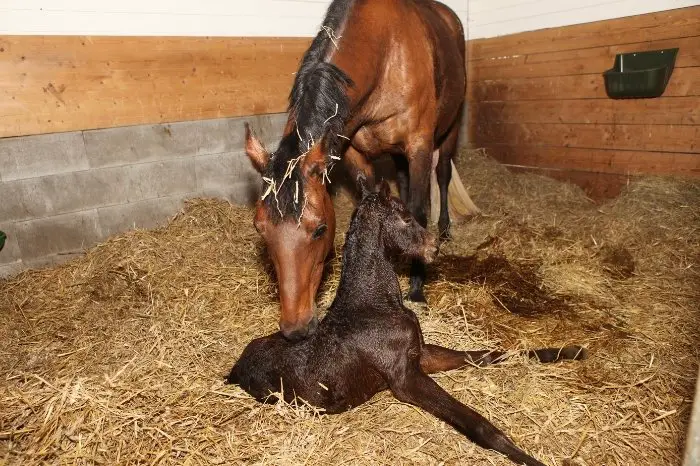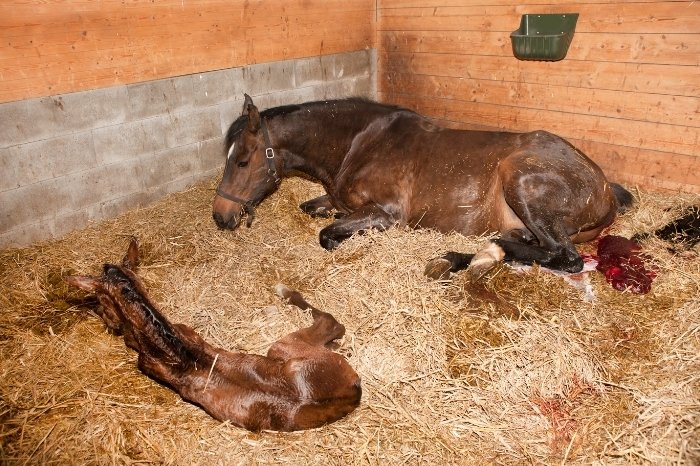Last Updated on October 15, 2021
Giving birth is a difficult and intensive process for a horse, and it often takes place very quickly. If you’ve ever been lucky enough to witness a horse giving birth, you will understand what a miraculous thing this is! But how long does it take for a horse to give birth?
The process of giving birth, also known as foaling or parturition, is a dangerous time for both the mare and the foal. It is important to know how long it should take and what signs to look out for. This means if you spot that the mare is having difficulties, you can intervene and get prompt veterinary assistance.
How Long Does It Take For A Horse To Give Birth?
The pregnancy of a horse normally lasts for 330 and 345 days, which is around 11 months. After this time the mare will go through a process called parturition or foaling – this is when she gives birth to the foal.
The process of foaling in horses takes place over several stages. Each stage is very different and lasts for a different length of time.

We will look at each stage in detail later in this article, but here is how long each stage should take:
- Stage 1: 1 to 4 hours
- Stage 2: 10 to 30 minutes
- Stage 3: 3 to 4 hours
So, if we add these stages together, we can see that the time it takes for a horse to give birth will be somewhere between 4 hours and 10 minutes up to 8 hours and 30 minutes.
Do Horses Give Birth Standing Up?
Horses have naturally evolved to many things standing up, including sleeping and giving birth. This is because horses are prey animals, and they need to be able to flee quickly from predators such as lions and tigers. They have retained these natural instincts even after centuries of domestication.
During parturition, the mare will remain standing for most of the time. The only time she will lay down is during the second stage of labor. This means she will only be laid down for about half an hour.
The mare lays down at this stage as this is when the foal is actually born. If she was to remain in a standing position, the foal would fall heavily to the ground and could be injured. There is also the risk that the umbilical cord will rupture prematurely, risking the health of the foal.
Some mares may also lay down and stand up repeatedly during the first stage of labor. This may be because the contractions are uncomfortable, and she is trying to ease the pain. This can also help the foal to move into the correct position to be born.
Pregnant Horse Giving Birth – What To Look For
When you have a pregnant mare, it is vital to know when they are due to give birth. If a mare has problems during the birthing process you must get veterinary help immediately. If not, you could lose both the mare and the foal.
For this reason, most horse owners watch their broodmares closely when they are approaching their due date. Some key signs will tell you that your mare is getting ready to foal:
-
Changes In Body Shape
In the weeks leading up to the birth, some of the ligaments around the uterus will start to stretch in preparation. This will lead to a change in the body shape of the mare. You will see and feel that the area of her hindquarters around the top of her tail will become soft and relaxed.
-
Behavioral Changes
If your mare lives as part of a herd, she will separate herself from the rest of the horses. This mimics the behavior of a horse in the wild, who would take herself off to give birth alone.
-
Mammary Gland Changes
The mammary glands, or udders, of the mare, will become swollen as they start to fill with milk. Two or three days before foaling the mare may develop waxy secretions from her teats.
What Are The Signs Of Labor In Horses?
So, we know that the horse has three stages of labor. Let’s take a look at what you will see during each stage of foaling:
-
Stage 1 – Preparation
The first stage of foaling, which lasts 1-4 hours, is where the mare will first show signs of giving birth. The mare will start to appear restless, grabbing food then walking around the stall. She may also paw and sniff at the ground.
During the stage, you might also see the mare swishing her tail and passing urine repeatedly. Her flanks will become sweaty and she may start to lay down and stand up towards the end of this stage.
-
Stage 2 – The Birth
When stage two of foaling begins, it all happens very quickly! The mare will lay down and heavy abdominal contractions will start. Her water bag will appear at the vulva and break, followed by the front feet of the foal.
Next, the foal’s head will appear, and the body of the foal normally follows quickly afterward. The mare will remain laid down for some time after foaling.

-
Stage 3 – The Afterbirth
Within 3-4 hours of birth, the mare should then pass the afterbirth, also called the placenta.
If you have a mare who is due to foal, it is a good idea to watch some videos on foaling or see a real-life foaling to help you understand what to expect.
Summary
So, as we’ve learned, it will take a mare up to 8 hours to go through all the stages of foaling. Timing these stages is very important, as you will need to get veterinary help if the mare is having difficulties. Learning the signs of each stage of the birthing process will help you to identify which stage of foaling the mare is at.
Do you have any questions about how long does it take for a horse to give birth? Or maybe you’ve been lucky enough to see a foal being born? Add a comment below this post and we’ll get back to you!

Kate Chalmers is a qualified veterinary nurse who has specialized in horse care for the vast majority of her career. She has been around horses since she was a child, starting out riding ponies and helping out at the local stables before going on to college to study Horse Care & Management. She has backed and trained many horses during her lifetime and competed in various equestrian sports at different levels.
After Kate qualified as a veterinary nurse, she provided nursing care to the patients of a large equine veterinary hospital for many years. She then went on to teach horse care and veterinary nursing at one of the top colleges in the country. This has led to an in-depth knowledge of the care needs of horses and their various medical ailments, as well as a life-long passion for educating horse owners on how to provide the best possible care for their four-legged friends.
Kate Chalmers BSc (Hons) CVN, Dip AVN (Equine) Dip HE CVN EVN VN A1 PGCE

